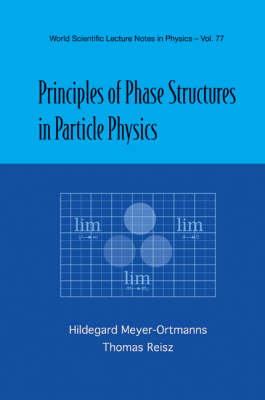
Principles Of Phase Structures In Particle Physics
Seiten
2006
World Scientific Publishing Co Pte Ltd (Verlag)
978-981-02-3441-6 (ISBN)
World Scientific Publishing Co Pte Ltd (Verlag)
978-981-02-3441-6 (ISBN)
- Titel z.Zt. nicht lieferbar
- Versandkostenfrei
- Auch auf Rechnung
- Artikel merken
The phase structure of particle physics shows up in matter at extremely high densities and/or temperatures as they were reached in the early universe, or in heavy-ion collisions, as they are performed in laboratory. This work covers a variety of analytical and numerical tools that are needed to study the phase structure of particle physics.
The phase structure of particle physics shows up in matter at extremely high densities and/or temperatures as they were reached in the early universe, shortly after the big bang, or in heavy-ion collisions, as they are performed nowadays in laboratory experiments. In contrast to phase transitions of condensed matter physics, the underlying fundamental theories are better known than their macroscopic manifestations in phase transitions. These theories are quantum chromodynamics for the strong interaction part and the electroweak part of the Standard Model for the electroweak interaction. It is their non-Abelian gauge structure that makes it a big challenge to predict the type of phase conversion between phases of different symmetries and different particle contents. The book is about a variety of analytical and numerical tools that are needed to study the phase structure of particle physics. To these belong convergent and asymptotic expansions in strong and weak couplings, dimensional reduction, renormalization group studies, gap equations, Monte Carlo simulations with and without fermions, finite-size and finite-mass scaling analyses, and the approach of effective actions as supplement to first-principle calculations.
The phase structure of particle physics shows up in matter at extremely high densities and/or temperatures as they were reached in the early universe, shortly after the big bang, or in heavy-ion collisions, as they are performed nowadays in laboratory experiments. In contrast to phase transitions of condensed matter physics, the underlying fundamental theories are better known than their macroscopic manifestations in phase transitions. These theories are quantum chromodynamics for the strong interaction part and the electroweak part of the Standard Model for the electroweak interaction. It is their non-Abelian gauge structure that makes it a big challenge to predict the type of phase conversion between phases of different symmetries and different particle contents. The book is about a variety of analytical and numerical tools that are needed to study the phase structure of particle physics. To these belong convergent and asymptotic expansions in strong and weak couplings, dimensional reduction, renormalization group studies, gap equations, Monte Carlo simulations with and without fermions, finite-size and finite-mass scaling analyses, and the approach of effective actions as supplement to first-principle calculations.
General Background from Statistical Physics; Field Theoretical Framework for Models in Particle Physics; Analytic Methods on the Lattice and in the Continuum; Numerical Methods in Lattice Field Theories; Effective Actions in the Continuum; Phenomenological Applications to Relativistic Heavy-Ion Collisions.
| Erscheint lt. Verlag | 7.12.2006 |
|---|---|
| Reihe/Serie | World Scientific Lecture Notes In Physics ; 77 |
| Verlagsort | Singapore |
| Sprache | englisch |
| Themenwelt | Naturwissenschaften ► Physik / Astronomie ► Atom- / Kern- / Molekularphysik |
| Naturwissenschaften ► Physik / Astronomie ► Hochenergiephysik / Teilchenphysik | |
| ISBN-10 | 981-02-3441-4 / 9810234414 |
| ISBN-13 | 978-981-02-3441-6 / 9789810234416 |
| Zustand | Neuware |
| Haben Sie eine Frage zum Produkt? |
Mehr entdecken
aus dem Bereich
aus dem Bereich
Buch | Softcover (2024)
Wiley-VCH (Verlag)
CHF 83,85


